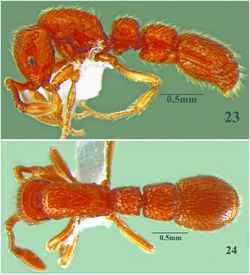Key to Cerapachys of India
This worker key is based on: Bharti H, Ali Akbar S. 2013b. Taxonomic studies on the ant genus Cerapachys Smith (Hymenoptera, Formicidae) from India. ZooKeys 336: 79–103. doi: 10.3897/zookeys.336.5719 PDF
You may also be interested in
- Cerapachys
- Ants of India (species list)
- India Regional Project page
1
- Antenna 9 segmented . . . . . 2
- Antenna 11 or 12 segmented . . . . . 3
2
return to couplet #1
- Larger species (HW 0.46–0.49 mm). Sculpture predominantly punctuate (Fig. 2A) . . . . . Ooceraea biroi
- Smaller species (HW 0.37–0.39 mm). Sculpture predominantly foveate (Fig. 2B) . . . . . Cerapachys alii
 Figure 2. A dorsal surface of Ooceraea biroi with conspicuous punctate sculpture B dorsal surface of Cerapachys alii with foveate sculpture. |
3
return to couplet #1
- Antenna 11 segmented. . . . . Cerapachys besucheti
- Antenna 12 segmented . . . . . 4
4
return to couplet #3
- Petiole with dorsum rounding into sides; dorsolateral margins absent or vestigial (Fig. 3A) . . . . . 6
- Petiole with strong overhanging dorsolateral margins (Fig. 3B) . . . . . 5
 Figure 3A. petiole of Cerapachys schoedli with dorsum rounding into sides without overhanging dorsolateral margins |
 Figure 3B. petiole of Cerapachys nayana with strong overhanging dorsolateral margins. |
5
return to couplet #4
- Head brown, trunk red or brown, petiole and postpetiole light to dark reddish, gaster brown or black. Dorsal surface of body shiny, with widely scattered, indistinct punctures, throughout the body (Fig. 4A) . . . . . Cerapachys longitarsus
- Head, trunk, petiole and postpetiole black coloured. Dorsal surface of body shiny, with widely scattered, indistinct punctures, mostly confined to postpetiole (Fig. 4B) . . . . . Cerapachys nayana
 Figure 4A. body of Cerapachys longitarsus in lateral view illustrating the characteristic bicolouration |
 Figure 4B. uniformly coloured body of Cerapachys nayana in lateral view. |
6
return to couplet #4
- Dorsal surface of petiolar node with a smooth, median area (Fig. 5A) . . . . . Cerapachys sulcinodis
- Dorsal surface of petiolar node rounded and punctuate, without a differentiated median smooth area (Fig. 5B) . . . . . 7
 Figure 5A. petiolar node of Cerapachys sulcinodis with smooth median area |
 Figure 5B. petiolar node of Cerapachys wighti without any median smooth area. |
7
return to couplet #6
- Punctures on dorsum of head relatively small, their diameter smaller than the
average distance separating them (Fig. 6A) . . . . . 8
- Punctures on head dorsum large, foveiform, dense, their diameter as large, or larger than, the average distance separating them, and in some cases these are contiguous (Fig. 6B) . . . . . 10
 Figure 6A. cephalic dorsum of Cerapachys schoedli illustrating small punctures with diameter less than the average distance separating them |
 Figure 6B. cephalic dorsum of Cerapachys wighti showing large punctures with diameter greater than space separating them |
8
return to couplet #7
- Declivity of propodeum with distinct cariniform margins, continuous across the dorsum; petiolar dorsum flat; colour other than black (Fig. 7A). . . . . . 9
- Declivity of propodeum without distinct cariniform margins, petiolar dorsum strongly convex; colour black (Fig. 7B) . . . . . Cerapachys anokha
 Figure 7. A body profile of Cerapachys indicus in lateral view showing declivity of propodeum with distinct cariniform margins B body profile of Cerapachys anokha in lateral view with propodeal declivity lacking distinct cariniform margins. |
9
return to couplet #8
- Shiny species; body sculpture reduced; eyes breaking the lateral margins of head; colour varies from light orange to dark red (Fig. 8A) . . . . . Cerapachys schoedli
- Dull coloured species; body sculpture prominent; eyes not breaking the lateral margins of head; colour brown to dark brown (Fig. 8B) . . . . . Cerapachys seema
 Figure 8A. shining cephalic dorsum of Cerapachys schoedli with reduced sculpture and eyes not breaking the lateral margins of head |
 Figure 8B. dull cephalic dorsum of Cerapachys seema with prominent sculpture and eyes breaking the lateral margins of head. |
10
return to couplet #7
- Eyes reduced (EL< 0.1mm; Fig. 9A) . . . . . Cerapachys wighti
- Eyes large (EL >0.2mm; Fig. 9B) . . . . . 11
 Figure 9A. head of Cerapachys wighti in lateral view illustrating smaller eyes |
 Figure 9B head of Cerapachys aitkenii in lateral view illustrating larger eyes. |
11
return to couplet #10
- Head reddish brown or red; trunk and both nodes red; gaster black or dark brown; dorsal surface of mesosoma densely and finely sculptured; foveate or rugo-reticulate (Fig. 10A) . . . . . Cerapachys aitkenii
- Body unicolorous, lighter brownish red; dorsal surface of mesosoma mostly smooth with few scattered punctures along sides (Fig. 10B) . . . . . Cerapachys indicus
 Figures 10. A body profile of Cerapachys aitkenii in lateral view illustrating the characteristic bicolouration and prominent foveate sculpture B body profile of Cerapachys indicus in lateral view illustrating unicolorous body colouration and with reduced punctuate sculpture. |















